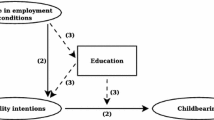Abstract
A theoretical and analytic model of fertility intentions is proposed which treats “don’t know” responses and other uncertain responses as distinct from more firm intentions. Methodologically, these analyses show that “don’t know” responses need not be treated as missing data, but instead are both valid and meaningful responses. Furthermore, eliminating these uncertain respondents would have the negative effects of distorting across survey comparisons in intentions due to shifts in aggregate uncertainty, reducing the likelihood of accurately detecting shifts in fertility intentions, and lessening the representatives of the sample analyzed. Substantively, in conjunction with Morgan (1981), these results show that the sharp 1965–76 decline in the likelihood of intending more births at parities 2 through 5 occurred as women halted childbearing at minimal acceptable levels and postponed further childbearing. With time (or age), this delayed fertility became fertility about which the respondent was uncertain and, finally, fertility foregone. Since 1970, similar shifts are observed at parities 0 and 1, perhaps foreshadowing an increase in voluntary childlessness and one-child families.
Similar content being viewed by others
References
Blake, Judith. 1974. Can We Believe Recent Data on Birth Expectations in the United States? Demography 11:25–44.
Coombs, Lolagene C. 1974. The Measurement of Family Size Preferences and Subsequent Fertility. Demography 11:587–611.
— 1978. How Many Children Do Couples Really Want? Family Planning Perspectives 10:303–308.
— 1979. Underlying Family-Size Preferences and Reproductive Behavior. Studies in Family Planning 10:25–36.
Davis, Kingsley. 1967. Population Policy: Will Current Programs Succeed? Science 158:730–739.
Duncan, Otis Dudley and J. A. McRae, Jr. 1979. Multiway Contingency Analysis with a Scaled Response or Factor. In Karl F. Schuessler (ed.), Sociology Methodology: 1979. San Francisco: Josey-Bass.
Easterlin, Richard A. 1978. What Will 1984 Be Like? Socioeconomic Implications of Recent Twists in Age Structure. Demography 15:397–432.
Fienberg, S. E. 1978. The Analysis of CrossClassified Data. Cambridge, Mass.: MIT Press.
Freedman, Ronald, Deborah S. Freedman, and Arland D. Thornton. 1980. Changes in Fertility Expectations and Preferences Between 1962 and 1977: Their Relation to Final Parity. Demography 17:365–378.
Goodman, L. A. 1969. How to Ransack Social Mobility Tables and Other Kinds of Cross-Classification Tables. American Journal of Sociology 75:1–39.
— 1979. Simple Models for the Analysis of Association in Cross-Classifications Having Ordered Categories. Journal of the American Statistical Association 74:537–552.
Haberman, S. J. 1979. Analysis of Qualitative Data. Vol. 2, New Developments. New York: Academic Press.
Hout, Michael. 1978. Determinants of Marital Fertility in the U.S., 1968–70: Inferences from a Dynamic Model. Demography 15:139–160.
Lee, Ronald D. 1981. A Model for Forecasting Fertility from Birth-Expectations Data. In Gerry E. Hendershot and Paul J. Placek (eds.), Predicting Fertility. Lexington, Mass.: D. C. Heath.
Morgan, S. Philip. 1981.Intention and Uncertainty at Later Stages of Childbearing: The United States 1965 and 1970. Demography 18:267–286.
Namboodiri, N. Krishnan. 1972. Some Observations on the Economic Framework for Fertility Analysis. Population Studies 26:185–206.
Namboodiri, N. Krishnan. Which Couples at Given Parities Expect to Have Additional Births? An Exercise in Discriminant Analysis. Demography 11:45–56.
National Center for Health Statistics. 1978. National Survey of Family Growth, Cycle I: Sample Design, Estimation Procedures, and Variance Estimation. Vital and Health Statistics Series 2, No. 76.
—. 1979. National Survey of Family Growth, Cycle II: Tape Contents Manual, Respondent File. Report no. NCHSIDF-79/0126. Hyattsville, Md.: National Center for Health Statistics.
Rindfuss, R. R. and L. L. Bumpass. 1978. Age and the Sociology of Fertility. Pp, 43–56 in Karl Taeuber, Larry Bumpass, and James Sweet (eds.), Social Demography. New York: Academic Press.
Ryder, Norman B. 1973. Recent Trends and Group Differences in Fertility. Pp, 57–69 in Charles F. Westoff (ed.), Toward the End of Growth: Population in America. Englewood Cliffs, N.J.: Prentice Hall.
U. S. Bureau of the Census. 1979. Current Population Reports, Series P-20, No. 325. Fertility of American Women: June 1978. Washington, D.C.: U. S. Government Printing Office.
—. 1980. Current Population Reports, Series P-20, No. 358. Fertility of American Women: June 1979. Washington, D.C.: U. S. Government Printing Office.
Westoff, Charles F. 1981. The Validity of Birth Intentions: Evidence for U. S. Longitudinal Studies. pp. 51–59 in Gerry E. Hendershot and Paul J. Placek (eds.), Predicting Fertility. Lexington, Mass.: D. C. Heath.
Westoff, Charles F. and Elise F. Jones. 1977. Contraception and Sterilization in the United States 1965–75. Family Planning Perspectives 9:153–157.
Westoff, Charles F. and James McCarthy. 1979. Population Attitudes and Fertility. Family Planning Perspectives 11:93–96.
Westoff, Charles F. and Norman B. Ryder. 1977. The Predictive Validity of Reproductive Intentions. Demography 14:431–453.
Author information
Authors and Affiliations
Rights and permissions
About this article
Cite this article
Morgan, S.P. Parity-specific fertility intentions and uncertainty: the United States, 1970 to 1976. Demography 19, 315–334 (1982). https://doi.org/10.2307/2060974
Issue Date:
DOI: https://doi.org/10.2307/2060974




